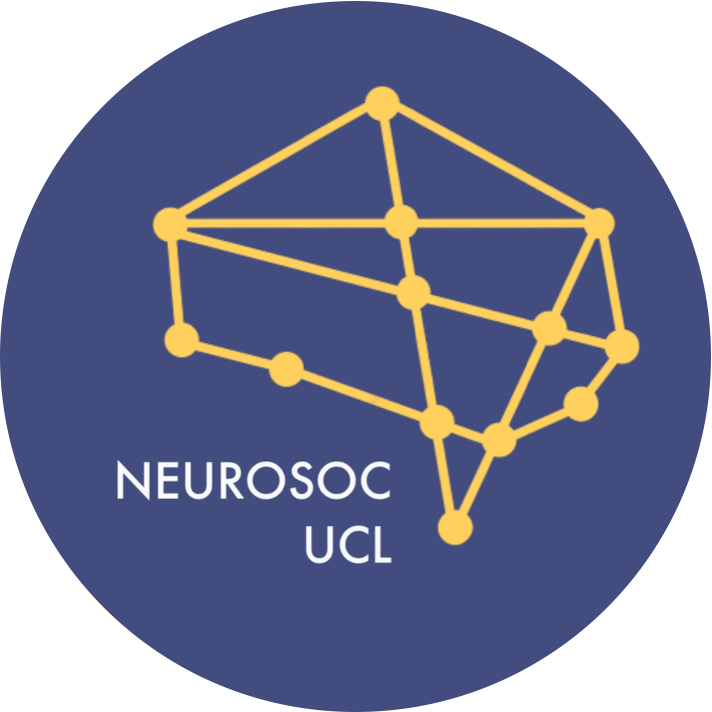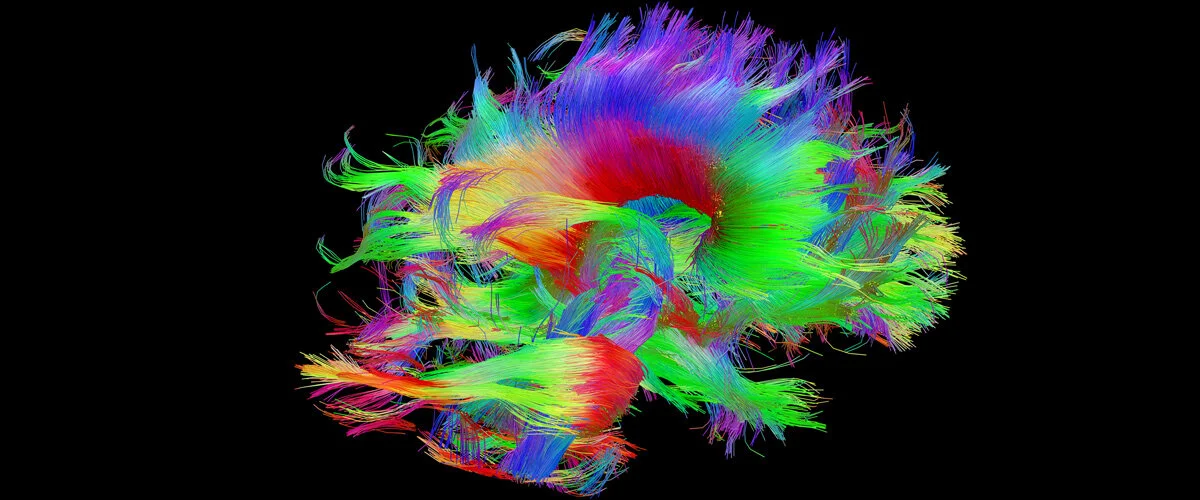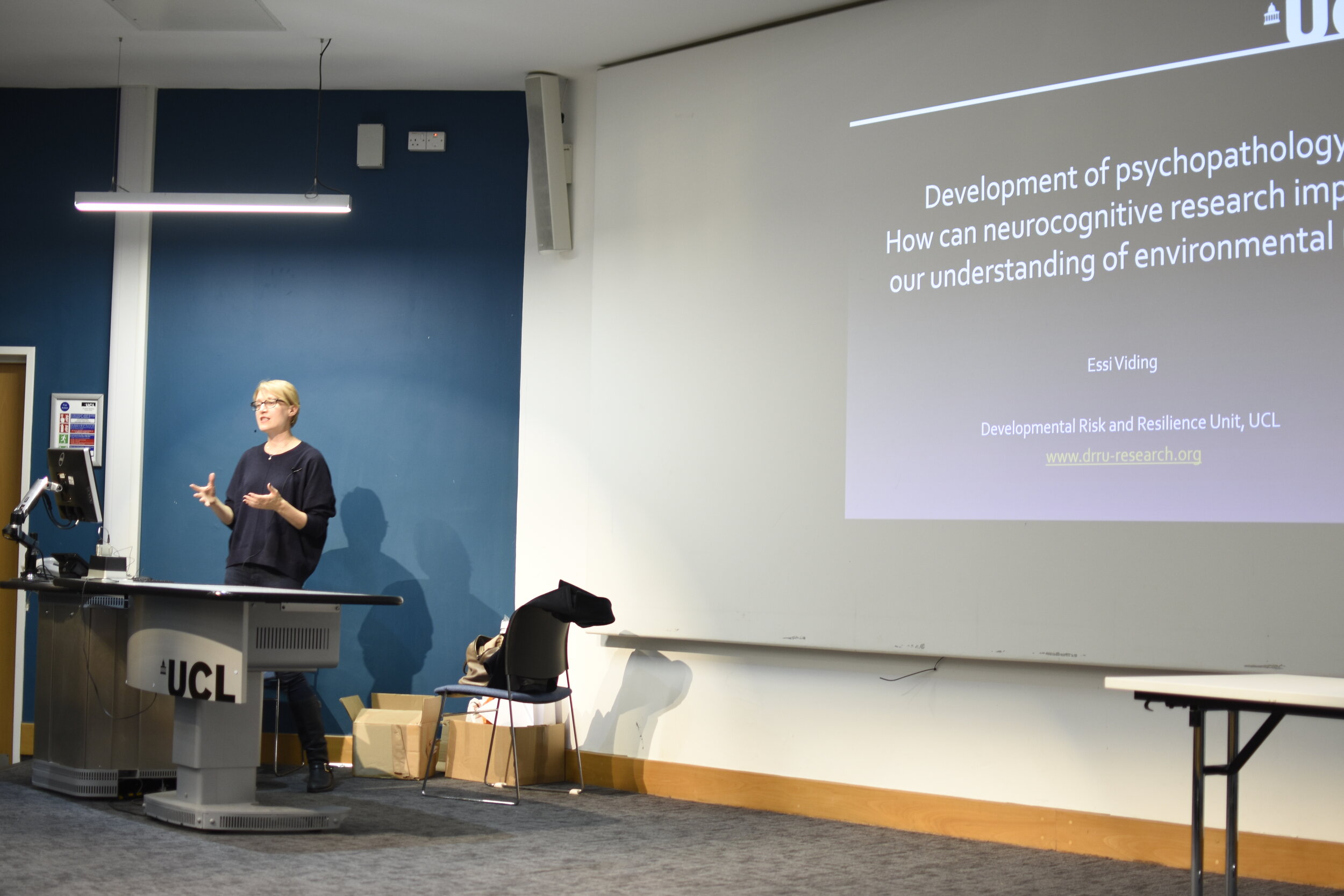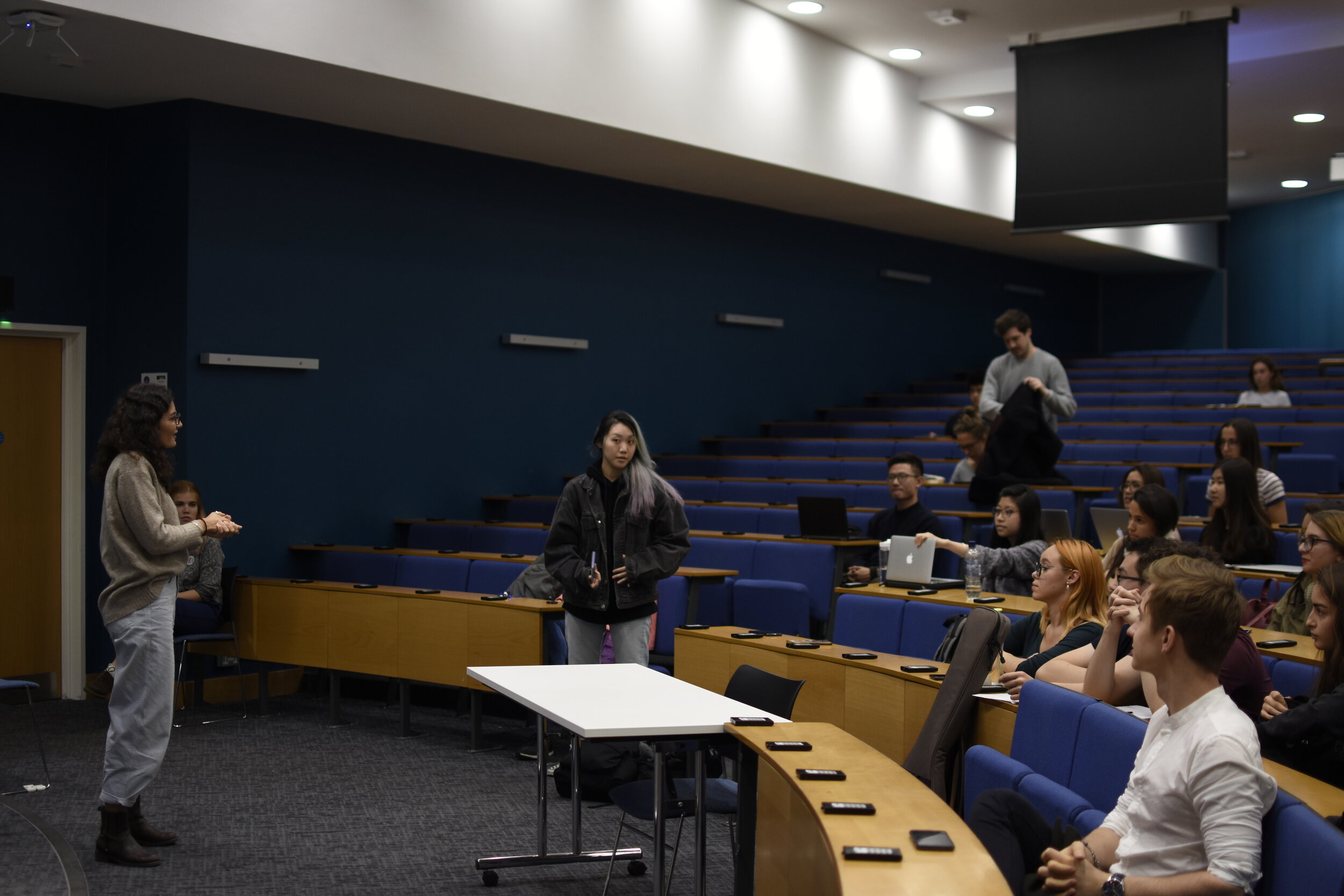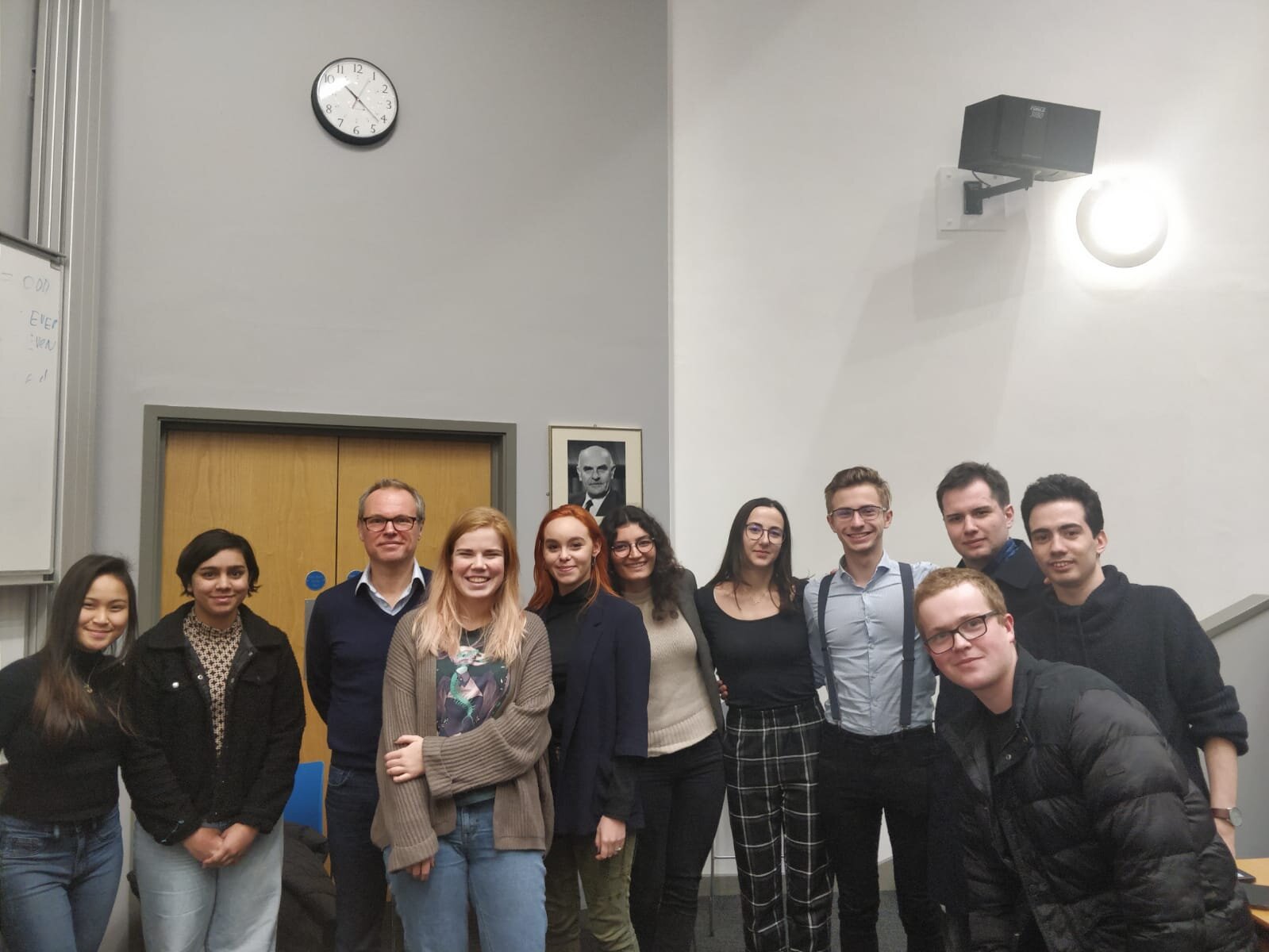Consciousness to psychopathology…
This academic year has a heap of interesting talks coming to a place near you (i.e. UCL)! Stay tuned to find out more via our Upcoming Events page, as well as our Facebook page and newsletter for all of the latest neuroscience news!
This year’s events:
Pizza Social!
Despite the rain, we all managed to have a spectacular time at our annual pizza meet-and-greet event. We got to hear from our committee more about their roles and why they’re here. It was amazing seeing all of the people that turned up. Success!
September 2019
Essi Viding - Development of Psychopathology
Professor Essi Viding shared many insights into the development of psychopathology. There are genetic and evironmental factors which all play a role in the framework of a psychopath. The talk featured a brief overview of the neurocognitive and genetically informative research into the developmental risk for conduct disorder. She used this overview as a framework for considering how atypical neurocognitive functioning may serve to generate and maintain maladaptive social interactions. She also argued that neurocognitive studies can inform our understanding of individuals as active agents in the generation of particular social ecologies and that unlocking the mechanisms of gene-environment and environment-environment correlation will be of key importance. Advances in this area of research have scope to inform theoretical understanding, as well as interventions designed to help children at risk of developing a disorder and their families.
Essi Viding is Professor of Developmental Psychopathology at the Division of Psychology and Language Sciences, University College London where she co-directs the Developmental Risk and Resilience Unit. She is also adjunct faculty at Yale University Medical School Child Study Centre. Her research combines a variety of methodologies in an effort to chart different developmental pathways to persistent antisocial behaviour. Professor Viding has received several prizes for her work, including the British Academy Wiley Prize in Psychology, the British Psychological Society Spearman Medal, and the Royal Society Rosalind Franklin Award.
October 2019
Brain Prize Winner, Péter Somogyi
The UCL Neuroscience Society hosted the prestigious Brain Prize winner Péter Somogyi from Oxford University. The presention was on "Defining neuronal circuits in relational brain space and time".
Co-ordinated neuronal activity is intrinsically linked with behaviour and malfunction of neuronal coordination results in psychiatric and neurological disorders. Timing is crucial for neuronal integration including events lasting from milliseconds up to several seconds. Much of the neuronal activity is rhythmic in the brain, as rhythmicity facilitates local and global interactions and enables the representation of temporal sequences. They explore how distinct neuronal types contribute to behaviour, and how the network mechanisms governing neuronal activity relate to both normal and abnormal brain function. They hypothesise that temporal coordination of neuronal assemblies is regulated by a temporal redistribution of inhibition over principal cell subcellular domains.
They reveal how the firing patterns of different GABAergic, cholinergic and glutamatergic neurons relate to network oscillations during different behavioural states such as movement and sleep and how their connectivity to other cells can provide a mechanism for these underlying network oscillations.
December 2019
Neural Mechanisms of Spatial Cognition - Prof Neil Burgess
Neil Burgess is a Professor of Cognitive and Computational Neuroscience at UCL, a Fellow of the Royal Society and the Academy of Medical Sciences, and leader of the Space and Memory Group. His lab uses a wide range of methods, including computational modelling, functional neuroimaging and electrophysiology to unravel the role of the hippocampus in spatial navigation and episodic memory, and to facilitate our understanding of human short-term memory. Burgess presented the society with a talk all about the neural mechanisms of spatial coding such as how there are frames of reference, the model of memory and imagery for scenes, and the interaction between place and grid cells.
Janurary 2020
Artificial Vs Natural Intelligence - Connectomics
Prof. Moritz Helmstädter is the director of the Max Planck institute for brain research in Frankfurt, Germany.
His research focuses on the development of connectomics and communication maps of neural circuits in order to understand the higher processing and storage of sensory experience. His lab uses cutting edge techniques such as Electron Microscopy to decipher the complex structure and wiring of neurons. Pioneering work includes the reconstruction of a piece of mouse retina (2013) and recently of the layer 4 of the mouse somatosensory cortex (2019) which constitute the largest connectomes to date!
Brains are highly interconnected networks of millions to billions of neurons. For a century, we have not been able to systematically map these connectivity networks. Only recently, using novel electron microscopy techniques and machine-learning based data analysis, the dense mapping of neuronal networks has become possible at a larger scale. This new field of connectomics is still limited by technology and requires next-generation human-machine interaction for data analysis, but it is already starting to provide exciting insights into how neuronal circuits operate in the brain. Our goal is to make connectomics a high-throughput screening technique for neuroscience, applicable to the large circuits in the mammalian cerebral cortex. We are using connectomic data from the cerebral cortex to analyze brain-implemented algorithms, extract possible imprints of sensory experience, investigate the postnatal development of neuronal circuits and study connectome alterations in models of psychiatric disease.
February 2020
Women’s Week: Communication Between Brain Cells and How it Goes Wrong
Our first talk in Women's Week was given by Prof Frances Edwards, Professor of Neurodegeneration in the Department of Neuroscience, Physiology and Pharmacology, UCL.
For the last decade, Prof Frances Edwards and her team have been studying the progression of Alzheimer's disease at the cellular and molecular level. During this talk, Prof Edwards discussed the research that's being carried out in her lab, but also talked about the journey it has taken to come studying this subject.
March 2020
Women’s Week: Public and Private Passions - Uta Frith in Conversation
We had the incredible opportunity to interview Prof Uta Frith from the UCL institute of Cognitive Neuroscience to encourage women to think about careers and opportunities in neuroscience.
Professor Uta Frith is a developmental psychologist best known for her pioneering work on Autism Spectrum Disorders and dyslexia. She is also an advocate for the advancement of women in science, has founded support networks for female scientists, co-founded UCL Women network and was named chair of the Royal Society’s Diversity Committee.
March 2020
Women’s Week: Discussing Representation and Women in Science
We are really happy to announce that we organised a panel discussion with:
- Dr Martina Wicklein, Senior Teaching Fellow in the Division of Biosciences
- Dr Daniah Trabzuni, Senior Research Associate at the Institute of Neurology in Queen Square
- Ilina Moitra, a 2nd year student in Bsc Neurosciences
- Charmian Dawson, Senior Teaching Fellow in the department of Structural and Molecular Biology and Life Sciences Faculty Lead for the BAME Awarding Gap Project
The event had themes such as representation and visibility of women, and less represented communities (including the LGBTQIA+, the disabled community, and ethnic minorities), in teaching and on both ends of that dialogue, how reflective the material we study is of our diverse identities, how this affects us (the students), and finally, how to change that misrepresentation.
March 2020
